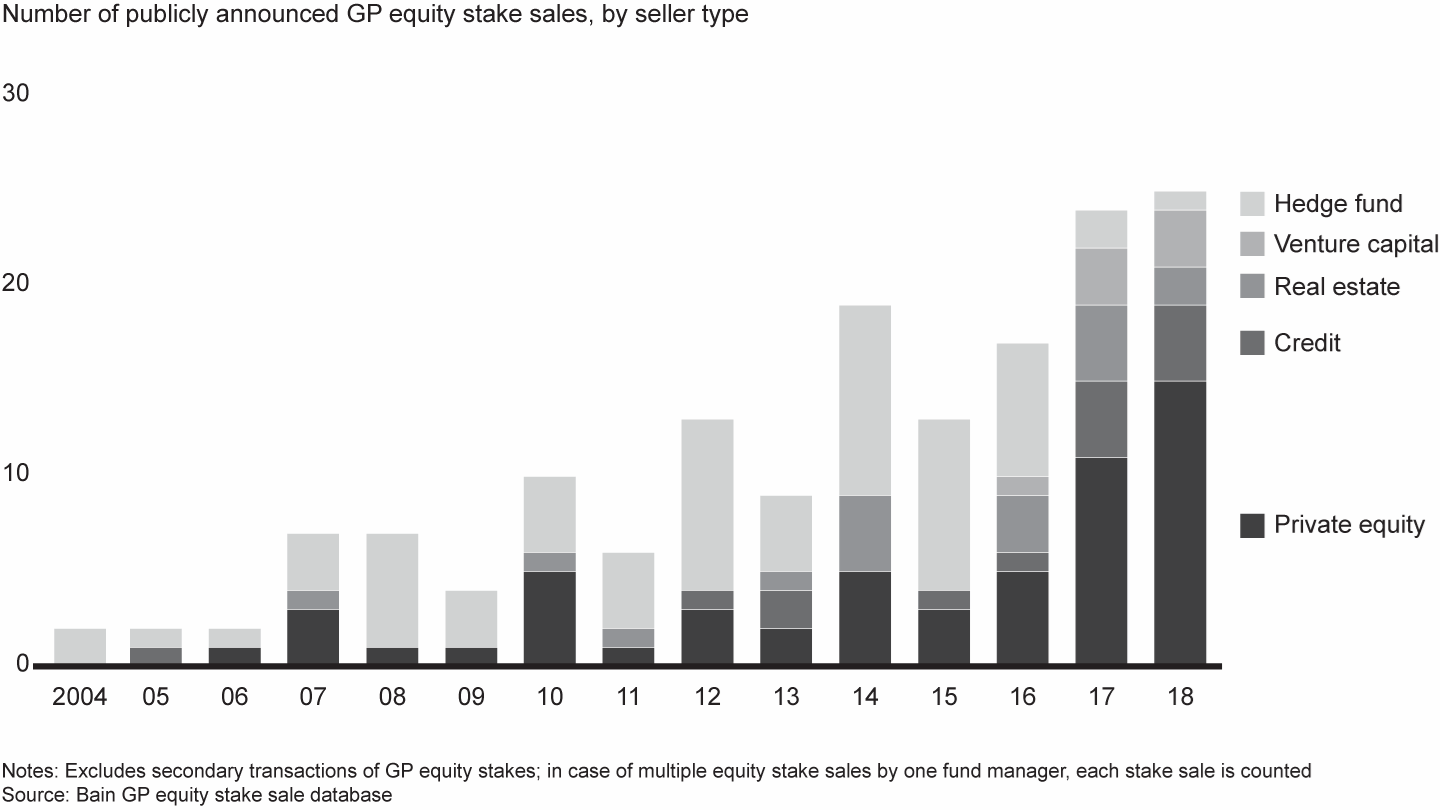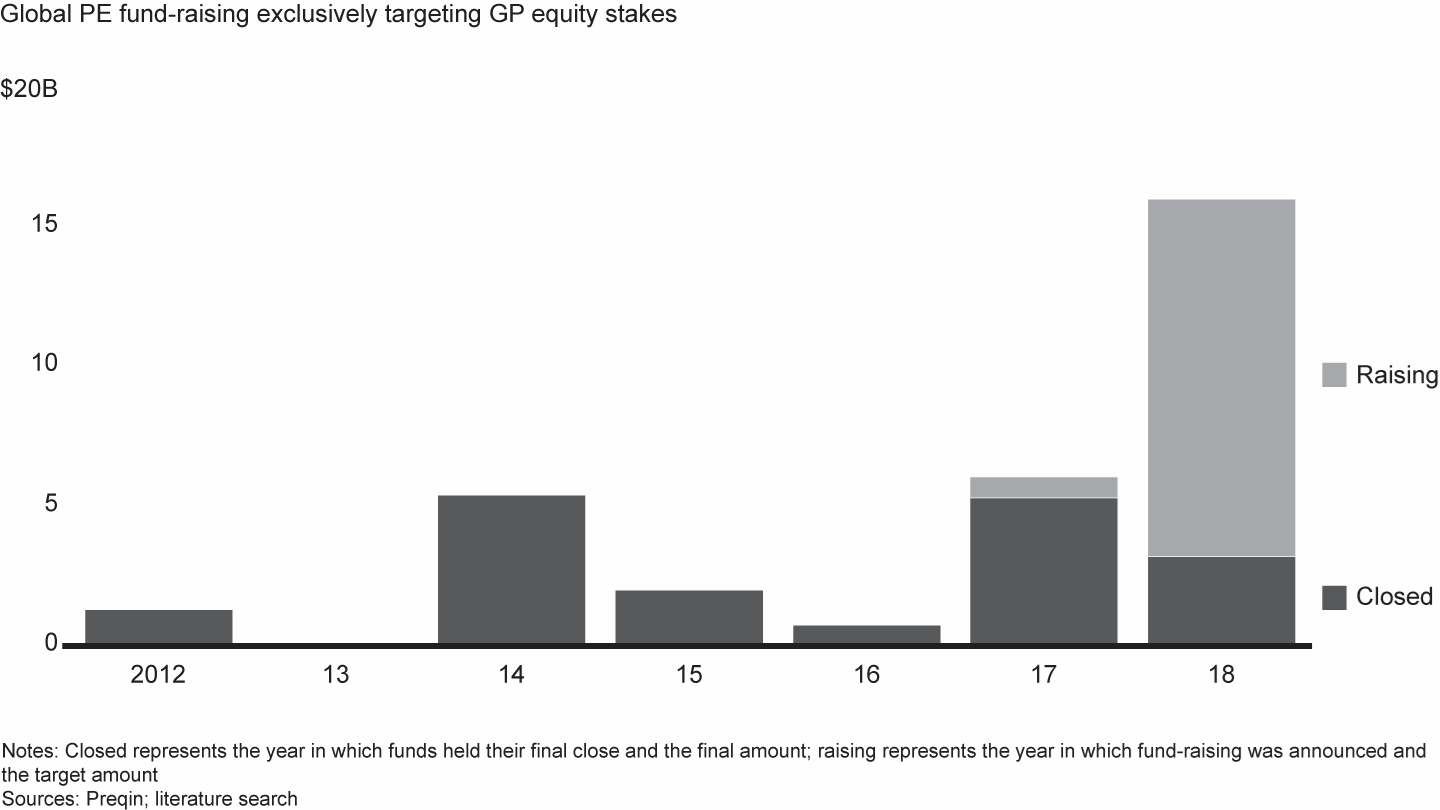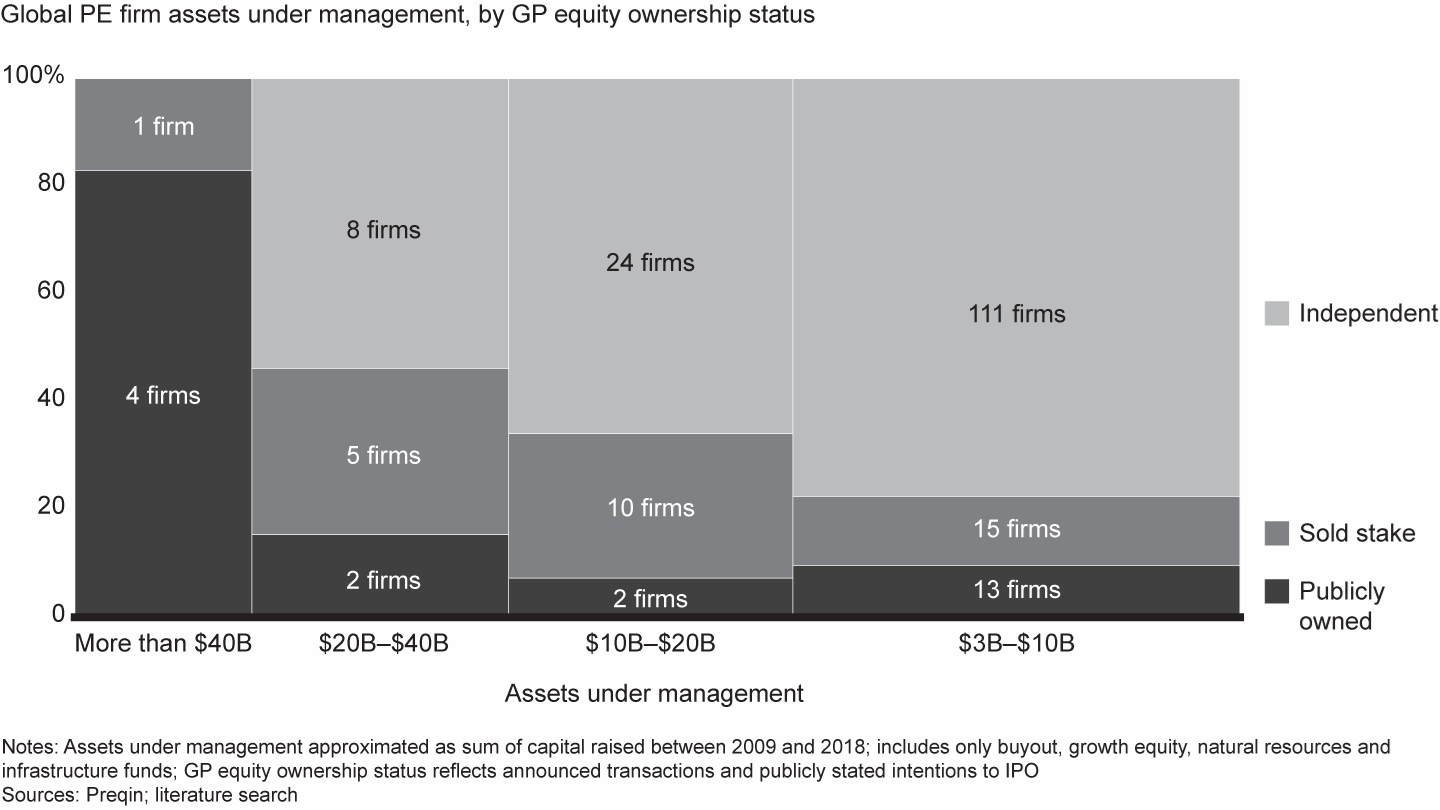Report

This article is part of Bain’s 2019 Global Private Equity Report. Explore the contents of the report here or download the PDF to read the full report.
While the buying and selling of minority stakes in PE firms isn’t exactly new, a once-infrequent practice has exploded into a full-blown market over the past several years. Since 2014, 119 firms have sold off pieces of themselves to raise capital—more than double the number over the previous five years. Until recently, hedge funds had dominated the relatively short list of firms seeking to raise capital this way, but that’s changed. Now, traditional, privately held PE firms like American Securities and Bridgepoint are the ones selling the most minority stakes (see Figure 1.24).
Sales of GP equity stakes have increased in recent years


The emergence of bulk buyers like Dyal Capital Partners (a division of Neuberger Berman) and Blackstone’s Strategic Capital Holdings has accelerated the trend. While the space was once the domain of institutional investors buying individual stakes, these firms are raising billions in capital for “fund of firms” vehicles that are dedicated to buying portfolios of GP minority stakes. Including players like Goldman Sachs’ Petershill fund and AlpInvest Partners, this group has raised more than $17 billion since 2012 to pursue the market (see Figure 1.25). They are clearly addressing hungry demand: A recent Coller Capital survey indicated that one in six LPs already invest in funds pursuing GP stakes, while another one in five are considering such investments.
Funds targeting GP equity stakes have raised $17 billion so far and are currently on the road looking to raise $14 billion more


The expanding market for GP minority stakes is a natural outgrowth of a maturing PE market. It’s easy to forget that private equity was a cottage industry 30 years ago, dominated by a relatively small club of scrappy founder-led firms courting a similarly narrow set of LPs. Having grown significantly faster than anyone anticipated, today’s PE marketplace raises issues and opportunities—for both GPs and LPs—that didn’t exist in the early days. The market for GP equity can support objectives on both sides of the transaction.
Funding succession and growth
For GPs, the need to manage generational change within the firm has been the primary motivation for selling minority stakes to date. This often isn’t the publicly stated reason, since firms are careful to avoid the appearance that they are cashing out the team responsible for historical performance. Yet the truth is that a growing number of firms face the challenge of succession planning as their founding partners approach retirement age and seek ways to monetize substantial ownership and carry stakes. Going public is one option, but that raises its own set of headaches and is not a viable path for most firms, given the scale and fee streams public markets demand. Selling a minority stake, on the other hand, is proving to be an efficient means of generating liquidity for many firms.
Increasingly, sellers are motivated by the operational and financial challenges that come with growth. Up to a point, firms can use lines of credit to fund their needs. But as they become larger and more sophisticated, many are looking to build their own balance sheets. They require capital to support acquisitions or expand into new geographies and sub-asset classes. They also need to beef up talent, add capabilities or fund internal investments in areas like digital technology and IT. H.I.G. Capital, for instance, sold a stake of less than 15% to Dyal in 2016; the firm plans to use the raised capital to invest in its own funds and to finance growth initiatives. And Vector Capital sold an unspecified stake to Dyal in 2018 to help build out its credit business.
Tapping cash flows
For investors, buying a minority stake offers the chance to boost performance by participating in a firm’s cash flows, not just the returns of an individual fund. The income stream from management fees and carried interest can be both steady and substantial. What drives disproportionate investor returns for this strategy is strong growth in assets under management (AUM). A firm capable of expanding AUM in both its core and newer products will generate a predictable fee income that increases into the future. Investors that buy well can make a lot of money from fees, with the additional prospect of strong carry income. At a time when LPs are clamoring to get into the best-performing funds, owning a stake may also offer another benefit. Striking a closer relationship with a GP can result in preferred allocations in a firm’s primary fund, as well as opportunities to coinvest alongside the firm.
Investing in minority stakes, of course, carries its own set of risks. While simply allocating capital to a PE fund has a time limit, taking an equity stake is a long-term bet on the firm’s success. The buyer is putting enormous faith in the firm’s ability to maintain performance over time, to continue to differentiate itself, to understand market changes, and to adjust strategy accordingly by choosing the right adjacencies and executing within them. Buyers are also betting that the leadership team will remain aligned over the years and renew itself with new talent as necessary.
History has shown, however, that a track record of poor performance can impair a firm’s equity or wipe it out completely by making it harder for the GP to raise new capital or causing the firm to wind down. There’s also the threat that selling equity in the firm will shrink the pot for existing partners, increasing the risk that top talent might leave. Even if firm leadership proves worthy of trust, negative macro trends can disrupt growth in AUM, crimping cash flow. These risks raise the bar for the buyer to do its due diligence, structure the deal thoughtfully and invest in firms that have earned its trust already.
Is the peak past?
A critical question is how much opportunity remains. Already, the pool of the most obvious candidates is shrinking. Many of the buyout, growth equity, infrastructure and natural resources firms with AUM of $3 billion or more have sold a minority stake or are publicly traded (see Figure 1.26). These “off the market” firms represent around 40% of the AUM for this group. Firms can sell additional stakes, but when buyers raise capital to fund acquisitions, the agreements tend to cap sales at 20% of a given firm’s equity, so as not to disrupt its incentive programs and provoke defections. That leaves buyers to scour the market for targets among other PE subcategories or among small GPs that might need capital to grow. Some are even trying to seed new firms. Three large institutional investors—the Alaska Permanent Fund Corporation, RPMI Railpen and Wafra, on behalf of Kuwait’s Public Institution for Social Security—have formed a coalition called Capital Constellation to fund promising start-up funds and spin-offs.
Because many large firms are either public or have already sold equity stakes, investor focus has shifted to midsize firms that promise future growth


At the same time, the pools of capital dedicated to buying GP minority stakes are proliferating. As competition for their equity increases, sellers are likely to drive harder bargains for a stake, preserving more value for themselves. Although public data is scarce, anecdotal evidence suggests that returns for those who invested early in this cycle have been sensational. One example: Dyal Capital Partners III, launched in 2015, is reporting a net internal rate of return (IRR) of 26%. Clearly, however, the early buys were done at attractive prices, as industry AUM expanded beyond what anyone would reasonably have expected. Now, with more savvy sellers and increased competition among buyers, returns for this strategy will likely come down. Publicly traded PE firms like Apollo, KKR and Blackstone, which together averaged an IRR in the mid to high single digits over the past five years, provide a good benchmark. It is reasonable to expect returns for private and publicly traded equity to converge over time.
As the opportunity set for primary equity stake sales is exhausted, it is almost certain that a secondary market for the stakes will develop. This would act as a relief valve for the capital raised for this strategy, as well as provide a path to liquidity for existing stake owners. In 2016, Goldman Sachs sold five stakes in hedge funds invested by Petershill Fund I to Affiliated Managers Group, a holding company for money management firms. While transactions like this have been few and far between to date, they are likely a harbinger of more to come.

Get Our Latest Private Equity Insights
Receive Bain’s landmark Global Private Equity Report each February, plus the latest insights and developments in private equity throughout the year.
Maximizing value
With so much capital chasing firm equity, GPs have a prime opportunity to tap the market. To make the most of it, they’ll need to develop a clear understanding of the firm’s full potential and build a convincing story around that vision. Otherwise, the firm risks doing what many did in the early days—giving away value. Maximizing the upside is no different from readying a portfolio company for sale. Leaders need to start with questions in a few key areas:
- What is our growth ambition for both our core business and adjacent products? Have we mapped out with confidence what the firm’s future cash flows will look like over the next 5 to 10 years?
- Do we really know what has driven historical performance in our core, and are we confident we can replicate that success in the future? Are we still focusing on the same kinds of deals, and if not, why not? How should our sweet spot expand, and why do we believe we will be successful doing so?
- For adjacencies, do the anticipated new product offerings take advantage of existing assets and capabilities? What will it cost to build new ones?
- Do we have a comprehensive plan for scaling our management platform to achieve expansion ambitions?
- Have we quantified the opportunity to maximize our cash flows by taking cost out of the business and becoming more efficient?
This article is part of Bain’s 2019 Global Private Equity Report. Explore the contents of the report here or download the PDF to read the full report.